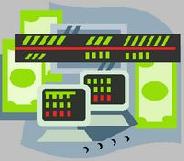
 |
|
| Financial Terms | |
| Fixed-income security |
|
Information about financial, finance, business, accounting, payroll, inventory, investment, money, inventory control, stock trading, financial advisor, tax advisor, credit.
Main Page: financial, stock trading, credit, tax advisor, payroll, investment, inventory, inventory control, |
Definition of Fixed-income security
Fixed-income securityA security that pays a specified cash flow over a
Related Terms:Yield to maturityThe percentage rate of return paid on a bond, note or other fixed income security if you Asset-backed securityA security that is collateralized by loans, leases, receivables, or installment contracts Convertible securityA security that can be converted into common stock at the option of the security holder, Derivative securityA financial security, such as an option, or future, whose value is derived in part from the Economic incomeCash flow plus change in present value. Exchangeable Securitysecurity that grants the security holder the right to exchange the security for the Fixed assetLong-lived property owned by a firm that is used by a firm in the production of its income.  Fixed asset turnover ratioThe ratio of sales to fixed assets. Fixed costA cost that is fixed in total for a given period of time and for given production levels. Fixed-annuitiesAnnuity contracts in which the insurance company or issuing financial institution pays a Fixed-charge coverage ratioA measure of a firm's ability to meet its fixed-charge obligations: the ratio of Fixed-datesIn the Euromarket the standard periods for which Euros are traded (1 month out to a year out) are Fixed-dollar obligationsConventional bonds for which the coupon rate is set as a fixed percentage of the par value. Fixed-dollar securityA nonnegotiable debt security that can be redeemed at some fixed price or according to Fixed-exchange rateA country's decision to tie the value of its currency to another country's currency, gold Fixed-income equivalentAlso called a busted convertible, a convertible security that is trading like a straight  Fixed-income instrumentsAssets that pay a fixed-dollar amount, such as bonds and preferred stock. Fixed-income marketThe market for trading bonds and preferred stock. Fixed price basisAn offering of securities at a fixed price. Fixed-price tender offerA one-time offer to purchase a stated number of shares at a stated fixed price, Fixed-rate loanA loan on which the rate paid by the borrower is fixed for the life of the loan. Fixed-rate payerIn an interest rate swap the counterparty who pays a fixed rate, usually in exchange for a Host securityThe security to which a warrant is attached. Hybrid securityA convertible security whose optioned common stock is trading in a middle range, causing Income beneficiaryOne who receives income from a trust. Income bondA bond on which the payment of interest is contingent on sufficient earnings. These bonds are Income fundA mutual fund providing for liberal current income from investments.  Income statement (statement of operations)A statement showing the revenues, expenses, and income (the Income stockCommon stock with a high dividend yield and few profitable investment opportunities. Investment incomeThe revenue from a portfolio of invested assets. Monthly income preferred security (MIP)Preferred stock issued by a subsidiary located in a tax haven. Mortgage pass-through securityAlso called a passthrough, a security created when one or more mortgage Net incomeThe company's total earnings, reflecting revenues adjusted for costs of doing business, Primitive securityAn instrument such as a stock or bond for which payments depend only on the financial SecurityPiece of paper that proves ownership of stocks, bonds and other investments. Security characteristic lineA plot of the excess return on a security over the risk-free rate as a function of Security deposit (initial)Synonymous with the term margin. A cash amount of funds that must be deposited Security deposit (maintenance)Related: Maintenance margin security market line (SML). A description of Security market lineLine representing the relationship between expected return and market risk. Security selection decisionChoosing the particular securities to include in a portfolio. Spread incomeAlso called margin income, the difference between income and cost. For a depository Taxable incomeGross income less a set of deductions. Underlying securityOptions: the security subject to being purchased or sold upon exercise of an option Underwriting incomeFor an insurance company, the difference between the premiums earned and the costs Variable price securityA security, such as stocks or bonds, that sells at a fluctuating, market-determined price. INCOME STATEMENTAn accounting statement that summarizes information about a company in the following format: INCOME TAXWhat the business paid to the IRS. NET INCOMEThe profit a company makes after cost of goods sold, expenses, and taxes are subtracted from net sales. RATIO OF NET INCOME TO NET SALESA ratio that shows how much net income (profit) a company made on each dollar of net sales. Here’s the formula: RATIO OF NET SALES TO NET INCOMEA ratio that shows how much a company had to collect in net sales to make a dollar of profit. Figure it this way: Fixed assetsThings that the business owns and are part of the business infrastructure – fixed assets may be Fixed costsCosts that do not change with increases or decreases in the volume of goods or services Intangible fixed assetsNon-physical assets, e.g. customer goodwill or intellectual property (patents and trademarks). Residual income (RI)The profit remaining after deducting from profit a notional cost of capital on the investment in a business or division of a business. Semi-fixed costs Costs that are constant within a defined level of activity but that can increase or decrease when Tangible fixed assetsPhysical assets that can be seen and touched, e.g. buildings, machinery, vehicles, computers etc. Dividend incomeincome that a company receives in the form of dividends on stock in other companies that it holds. Income StatementOne of the basic financial statements; it lists the revenue and expense accounts of the company. Interest incomeincome that a company receives in the form of interest, usually as the result of keeping money in interest-bearing accounts at financial institutions and the lending of money to other companies. Net incomeThe last line of the income Statement; it represents the amount that the company earned during a specified period. earnings before interest and income tax (EBIT)A measure of profit that fixed assetsAn informal term that refers to the variety of long-term operating fixed expenses (costs)Expenses or costs that remain the same in amount, income statementFinancial statement that summarizes sales revenue net income (also called the bottom line, earnings, net earnings, and netoperating earnings) Fixed Assets Turnover RatioA measure of the utilization of a company's fixed assets to Fixed Charge Coverage RatioA measure of how well a company is able to meet its fixed Security Market LineA graph illustrating the equilibrium relationship between the fixed costa cost that remains constant in total within a specified fixed overhead spending variancethe difference between the total actual fixed overhead and budgeted fixed overhead; fixed overhead volume variancesee volume variance residual incomethe profit earned by a responsibility center that exceeds an amount "charged" for funds committed to that center tax-deferred incomecurrent compensation that is taxed at a future date tax-exempt incomecurrent compensation that is never taxed Fixed assetAn item with a longevity greater than one year, and which exceeds a company’s Fixed costA cost that does not vary in the short run, irrespective of changes in any Fixed overheadThat portion of total overhead costs which remains constant in size IncomeNet earnings after all expenses for an accounting period are subtracted from all Income statementA financial report that summarizes a company’s revenue, cost of Income taxA government tax on the income earned by an individual or corporation. Marketable securityAn easily traded investment, such as treasury bills, which is Net incomeThe excess of revenues over expenses, including the impact of income taxes. Operating incomeThe net income of a business, less the impact of any financial activity, SecurityEither the collateral on a loan, or some type of equity ownership or debt, such common-size income statementincome statement that presents items as a percentage of revenues. fixed costsCosts that do not depend on the level of output. floating-rate securitysecurity paying dividends or interest that vary with short-term interest rates. income statementFinancial statement that shows the revenues, expenses, and net income of a firm over a period of time. residual incomeAlso called economic value added. Profit minus cost of capital employed. security market lineRelationship between expected return and beta. Disposable Incomeincome less income tax. Fixed Exchange RateAn exchange rate held constant by a government promise to buy or sell dollars at the fixed rate on the foreign exchange market. Incomes PolicyA policy designed to lower inflation without reducing aggregate demand. Wage/price controls are an example. National IncomeGDP with some adjustments to remove items that do not make it into anyone's hands as income, such as indirect taxes and depreciation. Loosely speaking, it is interpreted as being equal to GDP. National Income and Product AccountsThe national accounting system that records economic activity such as GDP and related measures. Permanent Income HypothesisTheory that individuals base current consumption spending on their perceived long-run average income rather than their current income. Real Incomeincome expressed in base-year dollars, calculated by dividing nominal income by a price index. Tax-Related Incomes Policy (TIP)Tax incentives for labor and business to induce them to conform to wage/price guidelines. Employee Retirement Income Security Act of 1974 (ERISA)A federal Act that sets minimum operational and funding standards for employee benefit Related to : financial, finance, business, accounting, payroll, inventory, investment, money, inventory control, stock trading, financial advisor, tax advisor, credit. |